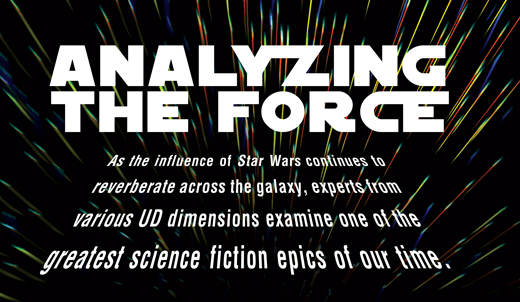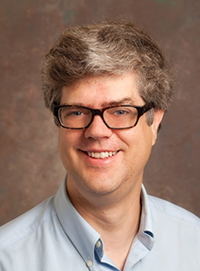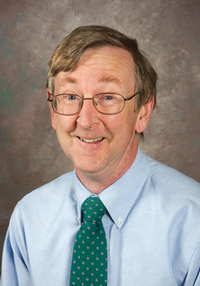

OUR FACULTY | ASTRONOMY John Gizis, professor of physics and astronomy, notes that many astronomers were influenced by science fiction films in their decision to study space. “Certainly this is true for me,” said Gizis, who now studies stars that are much smaller than the sun and also “brown dwarfs,” a type of failed star that has similarities to both stars and planets.
Q: What science did the films get surprisingly right?
A: The makers of the Star Wars films imagined exotic worlds like Tatooine, a desert planet with two suns; the Fourth Moon of Yavin, a moon covered in jungle; the Forest Moon of Endor; and the ice planet Hoth. Since the original trilogy, astronomers have found evidence of many planets unlike those in our solar system, including planets with two suns and gas giants whose moons might be inhabitable, and geologists have found evidence that Earth may have once been completely covered in ice. Although we don’t actually yet know of any worlds other than the Earth that are livable, the idea of extraordinarily diverse worlds seems to be right.
Q: What did they get wrong?
A: Obviously, large parts of films are impossible by scientific standards. It’s not really possible to travel faster than light, sound can’t travel in space, the X-Wing fighters wouldn’t bank as if they were planes, giant monsters surely can’t live in asteroids, and asteroids aren’t actually so close together that they would be hard to dodge. It’s not meant to be realistic, so none of that bothers me.
Q: What got you hooked on space science?
A: I loved the adventure most of all, but the idea of seeing other stars, planets, moons and asteroids really did stick with me. Using a NASA telescope (the K2 Kepler) in space to look at distant stars is not quite as exciting as in the Millennium Falcon, but it is still amazing.
Q: What new space adventures await the world in the next year or two?
A: I’m hoping to discover some new planets but they’d probably be too cold for people to live on. It’s very possible that in the next year NASA will announce the most Earth-like planet yet, a world warm enough to have liquid water, but I think it’d still be many years until we know if anyone or anything actually lives on it.

FILM STUDIES Thomas Leitch, professor of English specializing in film studies, turned down a chance to see the original Star Wars when it was released in 1977, telling a friend, “You must be kidding. I can’t believe grownups will want to see this.” He saw it years later when his young son insisted and includes it today when teaching about special effects.
Q: How has the film influenced the culture?
A: I often think about how people from my generation ask each other, “Where were you when you learned that JFK was killed?” And then, almost 40 years later, we had the Sept. 11 attacks, and this generation asks where someone was when that happened. But in between, I think the most bonding event might be: When did you first see Star Wars?
Q: What was the impact of the original Star Wars on filmmaking and the culture?
A: I think that Star Wars, more than any other film, put paid to the American Western, which used to be extremely popular. The story it told, of adventure and good vs. evil, is the kind of story that once would have been told in the Western genre. But after Star Wars, those stories were told in outer space. Its popularity really has very little to do with science fiction. It could have been set anywhere; it just happened to be set in outer space.
Article by Ann Manser, AS73
UD's droid restorer
Not many people can say they’ve seen a real Star Wars character in person. Mary Coughlin, AS05M, can say she’s seen one from the inside out.
It happened when she was a third-year intern at the National Museum of American History, where the iconic C-3PO droid costume was sent in 1984 after its role in “Star Wars: Episode VI—Return of the Jedi.” Conservators noticed ominous signs of wear, and soon Coughlin was part of restoration efforts that would end up taking months.
Part of the reason was sheer complexity. “It had come to us with the dressing instructions that were used by the actor, so we followed them in reverse to take it apart, but it was still harder than we anticipated,” says Coughlin, who would go on to graduate from the Winterthur/University of Delaware Program in Art Conservation.
Another glitch came when the team realized that the shiny gold color had changed over the years. “We ended up talking with the archivist at Lucasfilm, and she invited us out to Skywalker Ranch, where I got to see other pieces that were made in similar ways to C-3PO. It’s a process called vacuum metalizing, which is also used in making trophies, that puts very fragile, thin layers on an object.”
It ended up being a highlight of her time at UD—and also gave her department at the museum a bit of star luster itself. “People from other parts of the museum would come down to see him, which didn’t happen with most other things we worked on,” says Coughlin, now an assistant professor of conservation at George Washington University.
“UD was a place that gave me many opportunities,” she adds. “But I never expected a droid would be one of them.”
From UD to a galaxy long, long ago and far, far away...
There’s a little bit of UD in FN-2199.
The alphanumerically named Stormtrooper character in the latest Star Wars blockbuster gets his muscle from a lightsaber-resistant Z6 riot control baton, but his voice comes straight from UD graduate David Acord, AS94.
Acord actually voiced two characters and handled all sound editing in the latest episode of the iconic science fiction films, earning him and fellow editor Matthew Wood Oscar nominations for their work.
It’s a stunning high-point of a 20-year career in sound editing for Acord, who got his start in movies while studying English, photography and film theory at UD. The 44-year-old gives English and film professor Thomas Leitch a lot of credit for his success—and for his well-grounded view of the drive and passion needed to make it in Hollywood.
“What David had that set him apart was he really, really wanted this,” says Leitch. “I told him, ‘You really need a Plan B, but he didn’t want a Plan B. It’s a mark of who David is that he was not discouraged by the odds.”
That unrelenting passion would ultimately lead Acord to Lucasfilm’s Skywalker Sound division, where he has edited sound for two other Star Wars movies and related television programs. Over his career, he also has worked on such big feature films as Twelve Monkeys and Star Trek into Darkness.



